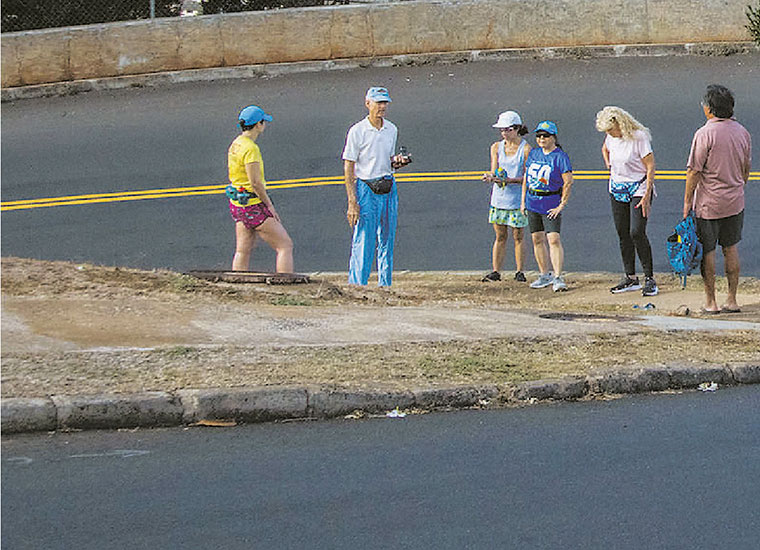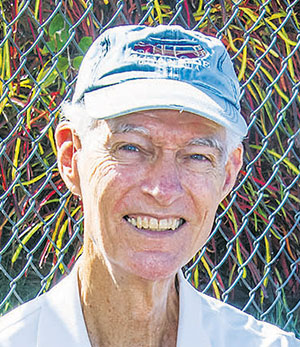By Steven Mark
Champion runner Brian Clarke goes the distance with his fitness students
The Loneliness of the Long Distance Runner,” a British coming-of-age film, uses running as a metaphor for life’s struggles. If Brian Clarke were to tell of his life as a runner, it would be called “The Friendliness of Long-Distance Running,” and it would be about the fun of running and getting in shape.
Clarke, a former Hawaii high school track star — he ran a then-record 4:28 mile for Saint Louis School in the early 1960s — helps local runners get the most from their minds and bodies. For the last 43 years, he’s been helping people prepare for the Honolulu Marathon and other distance races, imparting wisdom gleaned from top coaches to ambitious amateurs and casual runners.

PHOTO BY CRAIG T. KOJIMA / CKOJIMA@STARADVERTISER.COM
Walkers gathered last month on Sierra Drive with Brian Clarke, second from left, for an endurance training program.
“I work with recreational endurance athletes,” said Clarke, who at 78 still has the wiry build of a distance runner. “They’re not professional, top-notch runners. They may want to do a marathon, but they’re not going to be world beaters.”
More recently, he’s been working with baby boomers, helping them develop proper walking and running tech niques. “I like working with walkers, because, for whatever reason, they have just as much ambition and they have just as much desire to do the marathon as anyone else,” he said.
Clarke started his training program in the late 1970s. Recreational running was booming, with author Jim Fixx’s 1977 book “The Complete Book of Running” topping bestseller lists. “I looked at 8,000 people running the Honolulu Marathon and thought, ‘There’s a market,’ ” Clarke said.
He calls his training method the “Hard-Easy System.” It’s a personalized program geared toward making the individual find a level of training that is both efficient and safe. Most people, he said, try to do too much too soon, leading to discomfort or injury and eventually abandonment.
“You do a workout, and it’s either too hard, too easy or just right,” said Clarke, who has written four books on running.
He can run his training remotely. “I can listen to them on the telephone, and I can guide them and get them to exert the right amount of effort so that they don’t hurt themselves,” he said.
His current baby boomer class “meets” three times a week — twice over the phone, with participants following their own routes as they talk with Clarke, and once in person, when he observes and offers specific advice.
One recent Sunday, Clarke watched a group of trainees climb a steep street above Kaimuki. Many tried to power themselves up the hill with aggressive strides, but he advised them to take shorter steps.
“You have more ‘pusher’ muscles than ‘puller’ muscles,” he explained. “So you can come up the hill with more power if you push, and the only way you can push is by taking a shorter step. If you take a shorter step, you’re not out ahead of your center of gravity.”
One of the participants in the class, Karen Kau, is planning to run the Honolulu Marathon for the first time this year, after having previous plans interrupted by the pandemic. She’s been having health problems over the years, so relatives suggested that she train with Clarke. It’s been inspirational and encouraging.
“There’s lots of technical stuff that we go through. I’ve learned a lot,” said Kau, 59, adding that she’s run several 10K races and two half marathons in the last year. “Each week, we have something new.

PHOTO BY CRAIG T. KOJIMA / CKOJIMA@STARADVERTISER.COM
“I needed to find some exercise that will continue on until my later years, because I could not keep not exercising. Brian has (the course) three times a week, and it’s very important for me to be accountable.”
Another participant, Sheri Fitzgerald, had planned to run the marathon in 2014 but discovered she had breast cancer. She is in good health now and plans to run this year’s race. She likes Clarke’s instruction because it’s specific and personal. “He’s very detailed,” said Fitzgerald, 55. “He wants us to think and really pay attention to our body.”
She especially likes how Clarke portrays training as meditation, a way of “going within yourself,” she said.
Clarke’s methods have an impressive lineage. His coaches include Saint Louis’ Norman Tamanaha, an historic figure in Hawaii distance running, and the University of Hawaii at Manoa’s Stan Hattie, who had worked with Franz Stampfl, an advisor to Roger Bannister, the British runner who broke the 4-minute mile.
His current training program was derived mostly from his experience working with legendary coach Bob Bowerman, who led the track powerhouse University of Oregon to four NCAA championships. Clarke ran for Oregon, where he attained his best time in the mile, 4:06.
Clarke has not raced in 12 years, and does not run any more, preferring instead to walk. He strolls the steep streets near his Kaimuki home daily, sometimes reading a book on his Kindle, but mostly just taking in the sights and sounds.
“It doesn’t matter to me because I know that the level of exertion I’m putting out is sustained,” he said. “At that very slow pace I can just hone in on the fact that I’m enjoying this, I’m relaxed, I can think about other things.
“That’s the experience I’m looking for wherever I go and however I teach people. If they can just be relaxed and go at the right level of exertion for them, then it becomes sustainable. It becomes enjoyable and it’s not going to hurt them.”
Contact Brian Clarke at bcEnduranceTrainings.com.
See More News